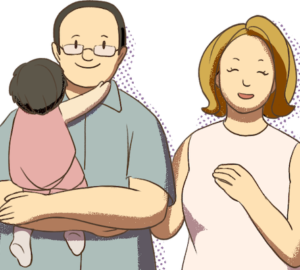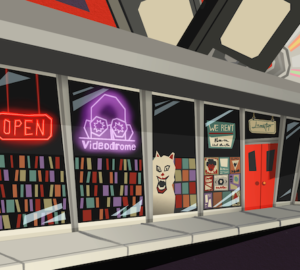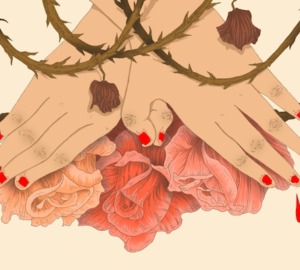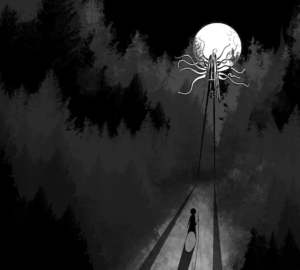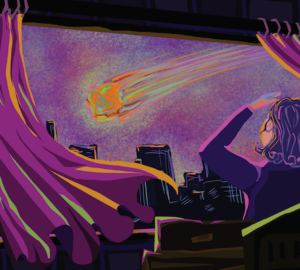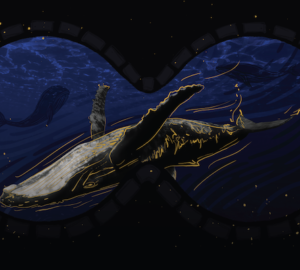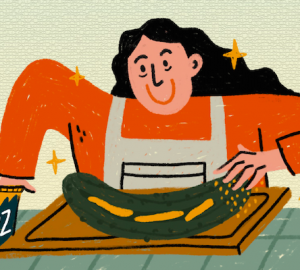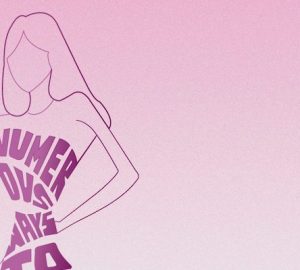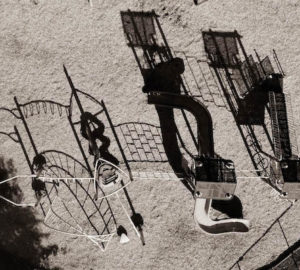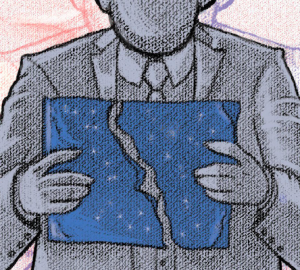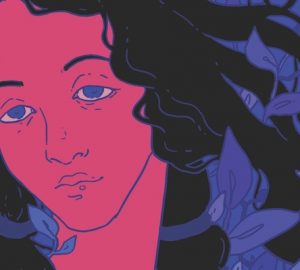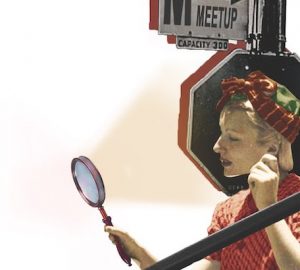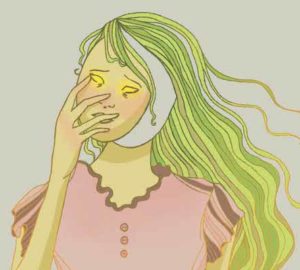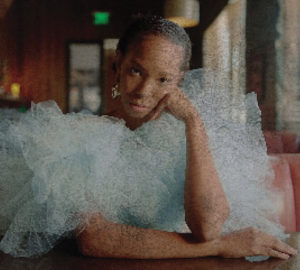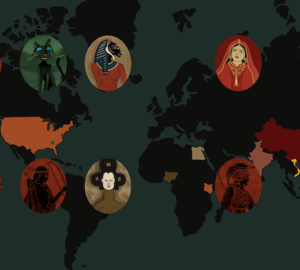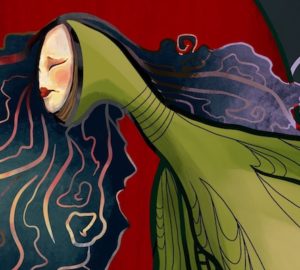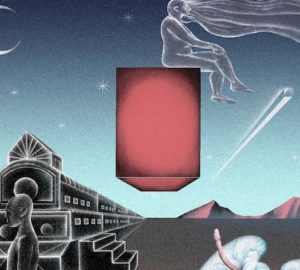Snapshots of the Dejak family.
Written by Stephanie Dejak
Illustrated by Eillie Wang
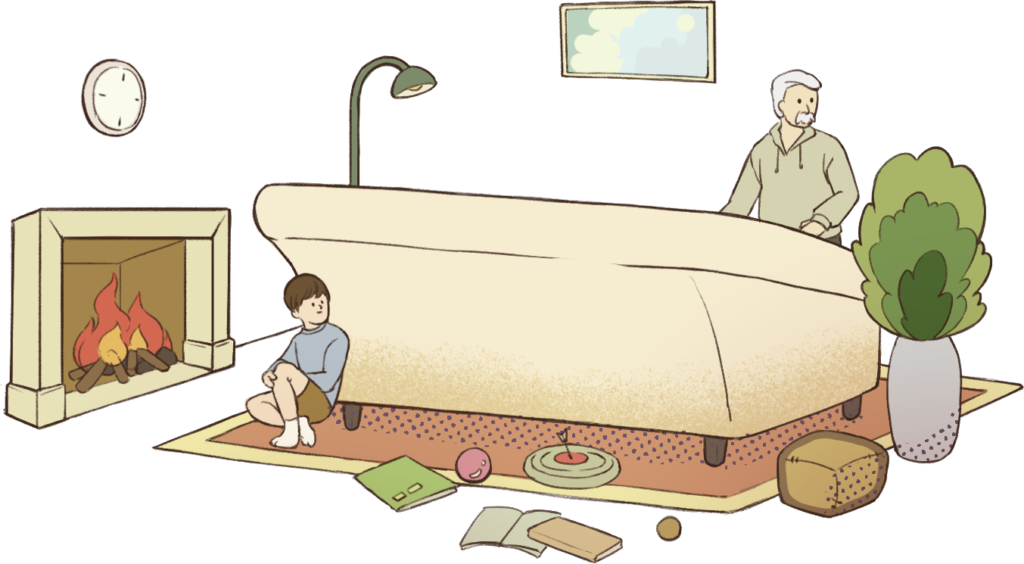
Apple tree
“1, 2, 3! Get off my grandpa’s apple tree!”
The white leather couch in the living room of our grandparents’ house on Sugarbush Lane was base, always. As long as you were touching the couch, you were safe, and you couldn’t be tagged.
The rules were that you couldn’t go upstairs to the guest bedrooms or downstairs to the basement, and you couldn’t hide in Miško’s office, but you could run through the kitchen as long as Stama wasn’t cooking dinner.
But if you were on base, and you heard Miško count to three, well … you scattered and you hoped that he didn’t tag you.
Apple Tree was our favorite game to play with our grandfather. He was nearly seventy years old, but he was in fantastic shape — he played tennis often and he walked around Gates Mills to the cul-de-sac and back every morning — so you actually had a fair chance of being tagged by him when he chased you around the house.
My youngest brother, David, would observe the chase for a while before deciding to join. He was able to develop his own strategy, which was to camp out on the other end of the couch while Miško chased the others. That way, he could just touch base whenever Miško came close, and he could avoid tiring himself out from over-sprinting.
That is, until one afternoon, Miško caught on to his plan. My seventy-year-old grandfather leapt over the couch hurdle-style, almost in slow motion, and tagged David in the midst of a roar of laughter.
The rest of us glared at him with wide eyes, shocked, but ultimately impressed.
“Again, Miško!” David said when his laughter died down. “Again!”
Cleveland, Ohio
Although my family visits the Cleveland area at least twice a year, it’s rare that my dad actually drives within the city limits when we visit. Maybe it’s because he’s spent so much of his life there and he’s tired of the gray skyline and all the concrete, but I was endlessly fascinated with any buildings taller than the Albemarle water tower in my hometown and I always wished that we could get even a glimpse of Cleveland’s buildings before driving into the suburbs of Gates Mills.
Gates Mills is approximately a nine-hour drive from Albemarle, North Carolina. Eight if your younger brother is driving, maybe nine and a half if you stop to eat anywhere other than the McDonald’s across from the Flying J gas station in Fort Chiswell, Virginia. Definitely ten if you happen to hit Thanksgiving traffic on Interstate 77, but fingers crossed that you don’t.
Dejak
The last name Dejak is pronounced as “Day-Yawk” in the Slovenian language. However, the American pronunciation is “Dee-Jack,” which is how my family members and I have pronounced it since the 1960s.
However, it does not stop common American Southerners from pronouncing it in a myriad of other ways, including but not limited to: “Duh-Shack,” “Dee-Shack,” “Duh-Jack,” “Duh-Jake,” and even “Dee …? Sorry, I’m not even going to attempt to pronounce that right.”
Foster’s Homemade Ice Cream
At the end of Istra Lane sat Foster’s Homemade Ice Cream. It was usually closed during the snowier months, but during the summer there was a line out the door and into the late June heat.
After growing bored of playing four square or basketball in the driveway, my cousins and I would beg our parents to let us ride our bikes across the usually busy Chardon Road for a cone of strawberry or chocolate chip cookie dough.
“Absolutely not,” they would say, and we would pout.
But sometimes, after a plate or two of salmon that Miško made paired with Stama’s carefully mashed (but not quite creamed) potatoes, Stama would ask us if we “still vant it ice cream.”
“Stama, we’re so stuffed from dinner,” we would say as we piled into her Cadillac. “There’s no way that we could eat anything else.”
“Oh, don’t vorry,” she would reply with a smile. “It vill melt through de cracks.”
Immigrants
Iris Bailin, a contributor to the New York Times, writes that “[Cleveland]’s metropolitan area contains the largest urban population of Slovenians — about 75,000 [as of 1987], counting second- and third-generation Americans — outside Ljubljana, Slovenia’s major city.”
According to the “Slovene” section of the Encyclopedia of Cleveland History at Case Western Reserve University, Slovenians that immigrated to Cleveland after World War II “were mainly political refugees.” The Slovenian community in Cleveland was also “augmented by the second generation,” meaning that second-generation Slovenians like my Teta Lenka (“teta” is Slovenian for “aunt”) who stayed in Cleveland and continued to embrace their heritage, have ensured that a Slovenian cultural presence remains in the area today.

John Dejak, both of them
John F. Dejak was born in Lipovec, Slovenia, which was considered a part of Yugoslavia at the time. He moved to America in the 1960s after meeting a Slovenian woman named Amelia Starasinič in Germany. The two of them got married and settled in Cleveland, Ohio, where John F. Dejak started his career as an engineer. They had their first child, a son, in June 1966. They named him John Nicholas Dejak, Nicholas being after Amelia’s oldest brother.
John N. Dejak grew up in Cleveland, Ohio and spoke Slovenian as his first language. He is not as fluent in it now at age fifty-five, but he was ridiculed in kindergarten once for referring to a fork as a “vilice.” He began working at his father’s machine shop, Dejak Machine and Tool Company, on weekends when he was fourteen, and began a career as a mechanical engineer after graduating from Cleveland State University in 1989. He had his first child, a daughter, in November 1998. They moved from Cleveland to Albemarle, North Carolina in 2000 when he got another engineering job. He never taught his daughter how to speak Slovenian.
Miško
Amelia, after divorcing John F. Dejak in 1995, met a Croatian man named Miško Maslac in 1997 at a holiday dinner at her niece’s house. They were happily married in 2000.
By 2000, Amelia already had four young grandchildren under the age of three. Each of these grandchildren spent extended periods of time with their grandparents, at Stama and Miško’s house, on Sugarbush Lane in Gates Mills, Ohio.
It wasn’t until 2007, when said grandchildren were between the ages of eight and eleven, that they learned that the word “Miško” does not mean “grandfather” in Slovenian. The grandchildren went with their parents to meet an old man in a Panera Bread on Mayfield Road, and they introduced him as Stariata, their grandfather.
“If ‘Stariata’ means ‘grandfather’ in Slovenian, then what does ‘Miško’ mean?” I later asked my dad.
“Mike,” he replied. “And it’s not Slovenian, it’s Croatian.”
Regardless, Miško will always mean “grandfather” to me.
Na zdravje
In the English language, the Slovenian phrase “na zdravje” translates to “bless you” or “to good health,” but it most commonly translates to “cheers.”
However, if you visit Cleveland and you’re having trouble with the pronunciation, usually muttering “nice driveway” in a Slovenian accent will do just fine.
This phrase pairs nicely with a short glass of slivovitz, also known as “Slovenian moonshine” to Clevelanders. Technically, slivovitz is Slovenian brandy made from plums, but it’s easier for my family to get Croatian rakija from Miško’s friend Hadjo in Cleveland, who makes his own grappa from grapes. But for us—slivovitz, brandy, rakija, grappa— they all have the same warm yet violent bitter taste, so we use “slivovitz” as a collective term.
It’s customary, maybe not to all Slovenians but to my family in particular, to pour a shot of slivovitz upon a safe arrival to Gates Mills. When a cheerful “na zdravje!” fills the house on Sugarbush Lane, whether it’s during Thanksgiving or Easter or somewhere in between, it’s always the beginning of a memorable family reunion.
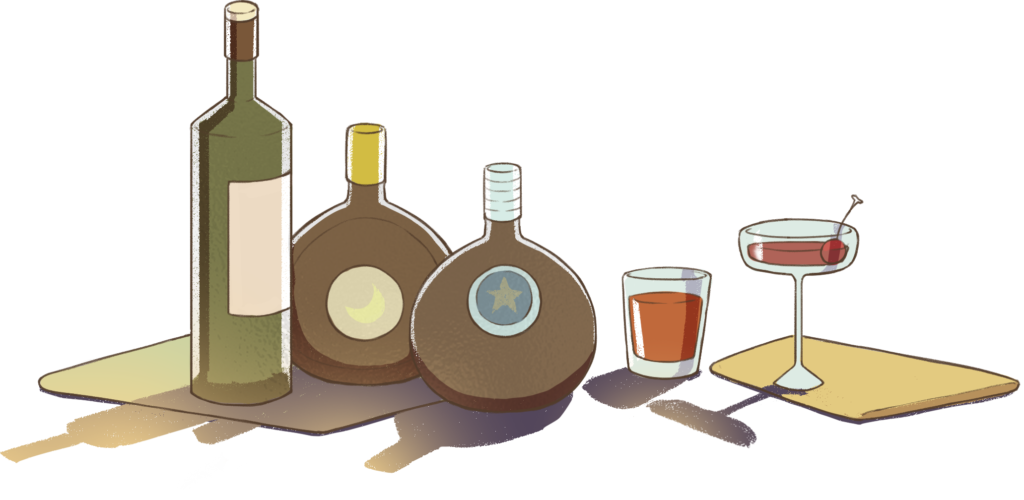
Palačinke
A Slovenian crepe recipe from the kitchen of Amelia Maslac
(Note: these measures can be halved or increased as needed)
7 oz milk
7 oz water
3 eggs
½ tsp salt
10 oz flour
Mix with a mixer until smooth.
“You have to experiment,” she says.
If it’s too thick, add more water. If it’s too thin, add more flour. Heat a skillet or pan and spray with Pam or oil. Pour the batter and rotate or swivel the pan so the batter covers the bottom. When the edges are brown, flip it over. Serve with powdered sugar and stuff with fillings of your choice, including but not limited to: fresh strawberries, raspberry jam, maple syrup, and/or cream cheese. But if you’re a younger brother of mine, usually a Slovenian sausage link will do.
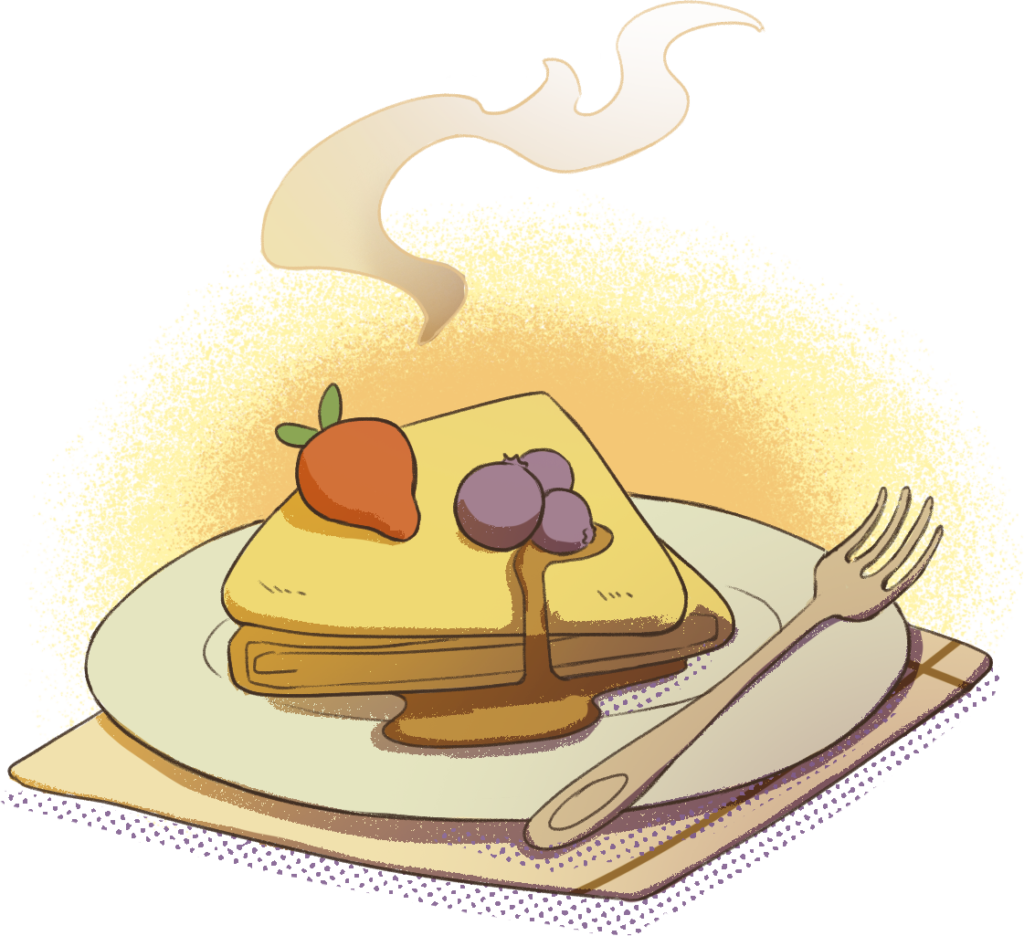
Stama
Technically, the word “Stama” doesn’t exist in the Slovenian language. The Slovenian word for “grandmother” is “Staramama,” but when my oldest cousin Sam was born, babbling the word “Staramama” sounded more like “Sta-ma-ma.”
By the time the rest of us cousins were born, she had shortened it to “Stama,” so that’s what we called her, too. Calling her “Staramama” at that age was such a mouthful. And even at twenty-three years old, sometimes it still feels like a mouthful.
Luckily, she still answers to “Stama.”
Torching
One of the only times that I remember driving through the actual Cleveland city limits was when we were going to the Slovenian National Home for the annual Martinovanje festival, which is a cocktail party for St. Martin’s Day filled with slivovitz and polka dancing. I was seventeen and I’d never been, even though most everyone in the car with us—my dad, my Teta Lenka, and my cousins—had been countless times.
As Teta Lenka drove, her and my dad laughed as they merged on to Interstate 90 and said in a Slovenian accent that we were “torching Cleveland.”
“What’s so funny?” I asked.
“We’re making fun of our dad,” my dad said.
“When your Stariata used to give us directions, he used to tell us to take I-90 ‘torching Cleveland,’” Teta Lenka said. “Except ‘torching’ isn’t really a word.”
“He would morph the words ‘towards’ and ‘approaching,’” my dad continued.
“So, it’s like Stariata’s version of Spanglish, I guess. Except with Slovenian,” I said.
“Slovenglish?”
“Exactly.”
Waitress
After World War II, Slovenia became a part of the Socialist Federal Republic of Yugoslavia. John F. Dejak received notice that he would be required to enlist in the army on Yugoslavia’s behalf, so he fled to a refugee camp in Austria in the late 1950s.
While he was there, he was sponsored by an American family who helped him relocate to Cleveland, Ohio, where he lived with a Slovenian family that helped him learn English before enlisting in the United States Army.
Since Slovenian culture has many German influences, my Stariata was quite familiar with German culture and requested that he be stationed there while in the United States Army. He wasn’t very close with his immediate family, but he had a teta who owned and operated a restaurant in Germany.
His teta was Slovenian as well, so she had no issue with hiring Slovenians to work in the restaurant. One of the waitresses had a family back in Slovenia that was struggling to make ends meet, so she came to Germany with a work visa to help provide for her family. While Stariata was visiting his teta at her restaurant, the waitress introduced herself as Amelia.
Zlato
Throughout their thirteen years of marriage, one of Miško’s nicknames for Stama was “zlato.” I heard him call her that all the time when I was younger, but since I never learned how to speak Slovenian myself, I didn’t think much of it.
It wasn’t until I was in college, years after Miško’s death, when I realized what the nickname actually translated to. A friend of mine had gotten a new tattoo of a Chinese symbol behind her ear, and out of curiosity, I went to Google Translate to see what the same word translated to in Slovenian.
Gold.
All those years, my grandfather was calling my grandmother “zlato,” which means “gold” in Slovenian.
And now that I’m much older, I can understand why. It’s the perfect word to describe everything that my Stama is—beautiful, rare, strong, and priceless.

